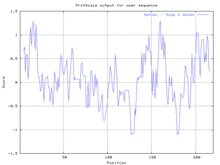Riboflavin kinase
| riboflavin kinase | |||||||||
|---|---|---|---|---|---|---|---|---|---|
 Crystal structure of riboflavin kinase from Thermoplasma acidophilum.[1] | |||||||||
| Identifiers | |||||||||
| EC no. | 2.7.1.26 | ||||||||
| CAS no. | 9032-82-0 | ||||||||
| Databases | |||||||||
| IntEnz | IntEnz view | ||||||||
| BRENDA | BRENDA entry | ||||||||
| ExPASy | NiceZyme view | ||||||||
| KEGG | KEGG entry | ||||||||
| MetaCyc | metabolic pathway | ||||||||
| PRIAM | profile | ||||||||
| PDB structures | RCSB PDB PDBe PDBsum | ||||||||
| Gene Ontology | AmiGO / QuickGO | ||||||||
| |||||||||
| Riboflavin kinase | |||||||||
|---|---|---|---|---|---|---|---|---|---|
 crystal structure of flavin binding to fad synthetase from thermotoga maritina | |||||||||
| Identifiers | |||||||||
| Symbol | Flavokinase | ||||||||
| Pfam | PF01687 | ||||||||
| InterPro | IPR015865 | ||||||||
| SCOP2 | 1mrz / SCOPe / SUPFAM | ||||||||
| |||||||||
| Riboflavin kinase | |||||||||||
|---|---|---|---|---|---|---|---|---|---|---|---|
| Identifiers | |||||||||||
| Symbol | Riboflavin_kinase | ||||||||||
| Pfam | PF01687 | ||||||||||
| InterPro | IPR015865 | ||||||||||
| |||||||||||
In enzymology, a riboflavin kinase (EC 2.7.1.26) is an enzyme that catalyzes the chemical reaction
- ATP + riboflavin ADP + FMN
Thus, the two substrates of this enzyme are ATP and riboflavin, whereas its two products are ADP and FMN.
Riboflavin is converted into catalytically active cofactors (FAD and FMN) by the actions of riboflavin kinase (EC 2.7.1.26), which converts it into FMN, and FAD synthetase (EC 2.7.7.2), which adenylates FMN to FAD. Eukaryotes usually have two separate enzymes, while most prokaryotes have a single bifunctional protein that can carry out both catalyses, although exceptions occur in both cases. While eukaryotic monofunctional riboflavin kinase is orthologous to the bifunctional prokaryotic enzyme,[2] the monofunctional FAD synthetase differs from its prokaryotic counterpart, and is instead related to the PAPS-reductase family.[3] The bacterial FAD synthetase that is part of the bifunctional enzyme has remote similarity to nucleotidyl transferases and, hence, it may be involved in the adenylylation reaction of FAD synthetases.[4]
This enzyme belongs to the family of transferases, to be specific, those transferring phosphorus-containing groups (phosphotransferases) with an alcohol group as acceptor. The systematic name of this enzyme class is ATP:riboflavin 5'-phosphotransferase. This enzyme is also called flavokinase. This enzyme participates in riboflavin metabolism.
However, archaeal riboflavin kinases (EC 2.7.1.161) in general utilize CTP rather than ATP as the donor nucleotide, catalyzing the reaction
- CTP + riboflavin CDP + FMN [5]
Riboflavin kinase can also be isolated from other types of bacteria, all with similar function but a different number of amino acids.
Structure[]


The complete enzyme arrangement can be observed with X-ray crystallography and with NMR. The riboflavin kinase enzyme isolated from Thermoplasma acidophilum contains 220 amino acids. The structure of this enzyme has been determined X-ray crystallography at a resolution of 2.20 Å. Its secondary structure contains 69 residues (30%) in alpha helix form, and 60 residues (26%) a beta sheet conformation. The enzyme contains a magnesium binding site at amino acids 131 and 133, and a Flavin mononucleotide binding site at amino acids 188 and 195.
As of late 2007, 14 structures have been solved for this class of enzymes, with PDB accession codes 1N05, 1N06, 1N07, 1N08, 1NB0, 1NB9, 1P4M, 1Q9S, 2P3M, 2VBS, 2VBT, 3CTA, 2VBU, and 2VBV.
References[]
- ^ PDB: 3CTA; Bonanno, J.B.; Rutter, M.; Bain, K.T.; Mendoza, M.; Romero, R.; Smith, D.; Wasserman, S.; Sauder, J.M.; Burley, S.K.; Almo, S.C. (2008). "Crystal structure of riboflavin kinase from Thermoplasma acidophilum". Cite journal requires
|journal=(help) - ^ Osterman AL, Zhang H, Zhou Q, Karthikeyan S (2003). "Ligand binding-induced conformational changes in riboflavin kinase: structural basis for the ordered mechanism". Biochemistry. 42 (43): 12532–8. doi:10.1021/bi035450t. PMID 14580199.
- ^ Galluccio M, Brizio C, Torchetti EM, Ferranti P, Gianazza E, Indiveri C, Barile M (2007). "Over-expression in Escherichia coli, purification and characterization of isoform 2 of human FAD synthetase". Protein Expr. Purif. 52 (1): 175–81. doi:10.1016/j.pep.2006.09.002. PMID 17049878.
- ^ Srinivasan N, Krupa A, Sandhya K, Jonnalagadda S (2003). "A conserved domain in prokaryotic bifunctional FAD synthetases can potentially catalyze nucleotide transfer". Trends Biochem. Sci. 28 (1): 9–12. doi:10.1016/S0968-0004(02)00009-9. PMID 12517446.
- ^ Ammelburg M, Hartmann MD, Djuranovic S, Alva V, Koretke KK, Martin J, Sauer G, Truffault V, Zeth K, Lupas AN, Coles M (2007). "A CTP-Dependent Archaeal Riboflavin Kinase Forms a Bridge in the Evolution of Cradle-Loop Barrels". Structure. 15 (12): 1577–90. doi:10.1016/j.str.2007.09.027. PMID 18073108.
Further reading[]
- CHASSY BM, ARSENIS C, MCCORMICK DB (1965). "The Effect of the Length of the Side Chain of Flavins on Reactivity with Flavokinase". J. Biol. Chem. 240: 1338–40. PMID 14284745.
- GIRI KV, KRISHNASWAMY PR, RAO NA (1958). "Studies on plant flavokinase". Biochem. J. 70 (1): 66–71. doi:10.1042/bj0700066. PMC 1196627. PMID 13584303.
- KEARNEY EB (1952). "The interaction of yeast flavokinase with riboflavin analogues". J. Biol. Chem. 194 (2): 747–54. PMID 14927668.
- McCormick DB; Butler RC (1962). "Substrate specificity of liver flavokinase". Biochim. Biophys. Acta. 65 (2): 326–332. doi:10.1016/0006-3002(62)91051-X.
- Sandoval FJ, Roje S (2005). "An FMN hydrolase is fused to a riboflavin kinase homolog in plants". J. Biol. Chem. 280 (46): 38337–45. doi:10.1074/jbc.M500350200. PMID 16183635.
- Solovieva IM, Tarasov KV, Perumov DA (February 2003). "Main physicochemical features of monofunctional flavokinase from Bacillus subtilis". Biochemistry (Moscow). 68 (2): 177–81. doi:10.1023/A:1022645327972. PMID 12693963. S2CID 35221624.
- Solovieva, I.M.; Kreneva, R.A.; Leak, D.J.; Perumov, D. A. (January 1999). "The ribR gene encodes a monofunctional riboflavin kinase which is involved in regulation of the Bacillus subtilis riboflavin operon". Microbiology. 145: 67–73. doi:10.1099/13500872-145-1-67. PMID 10206712.
- EC 2.7.1
- Enzymes of known structure
